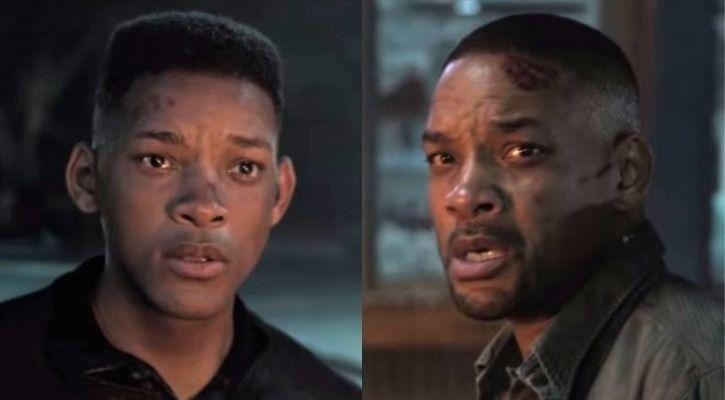Films depicting clones, in showing us their versions of what two humans with identical genomes would be like, and how they would relate to each other, take their own stances on the nature vs. nurture debate. While a wide variety of clones have made it to screens over the years, the differences between them have not really followed trends or evolved in ways reflective of our ever-growing scientific understanding.
The scientific knowledge demonstrated by most clone films is elementary at best, and Gemini Man is no exception. In a pivotal scene, Henry (Smith) tries to appeal to his clone, Clay (also Smith), by emphasizing their connection through listing traits he presumes the other man must share. There are some that make sense. He, for instance, mentions a hatred of cilantro, which several investigations have linked to a particular allele (that is, a version) of the OR6A2 gene that causes individuals to taste a strong soapy flavor in cilantro that others do not. However, the shared trait which the film gives the utmost importance — a severe bee sting allergy — is actually one of the worst choices it could have made in terms of accuracy. While some studies have found evidence that certain alleles of particular genes might potentially predispose individuals to a bee sting allergy, it is a tentative link, and far more evidence has connected the development of allergies to environmental factors. Long story short, there is no “bee sting allergy” gene. In Gemini Man, Clay feels the need to test Henry’s allergy in order to prove the man is truly his genetic identical, and while it’s a set-up that raises the stakes and makes for a tense scene, in actual fact it makes no sense at all. Allergies don’t work that way.
But all of this still deals with what we actually do know, and writers not doing their research—or, more forgivingly, taking significant creative license. Putting inaccuracies aside, perhaps one of the most interesting things about cloning stories is how so many lean heavily on the side of genetic determinism — the “nature” side of the nature vs. nurture debate. Most clone films, Gemini Man included, hold genes fully responsible for things, like allergies, in ways that are contrary to our current scientific understanding, so it’s perhaps not surprising that they also tend to credit genes for things for which scientists have no conclusive answers, like personality, taste, likes and dislikes.
Many of the most concerning narratives and prescient fears revolving around cloning and genetic engineering also depend on a high degree of genetic determinism. Neo-eugenics and the prospect of “designer babies” depend on traits like intelligence being genetically hard-wired. If whatever made Mozart Mozart and Einstein Einstein is environmental or some quality that defies quantification — that is, anything other than genes — these controversial schools of thought lose much of their steam.
Another intriguing trend regarding on-screen cloning is the frequency with which the very term “cloning” is misapplied. Clones are genetically identical. You take the DNA-housing nucleus from an existing individual and, for lack of a more apt analogy, cut and paste it into a fertilized egg that has had its nucleus removed. You don’t mess with the DNA at all. Changing the DNA is genetic engineering. So, if you take someone’s DNA, modify it, and then use that DNA to create a new individual, that new individual is not a clone. Almost every major film and TV show to tackle “cloning” has in actual fact been about genetic engineering. In Moon, for instance, the short-lived Sam “clones” made to mine helium-3 on the moon are not really clones at all because they have been genetically modified to have a limited lifespan.
Gemini Man is somewhat unusual in that it does, to some extent, implicitly make a distinction between a clone and a genetically engineered individual in the difference between Clay, a genuine clone, and the unnamed adolescent super-soldier clearly modified from Henry’s DNA. However, the film never really makes this distinction explicit and fails to clarify that “clone” isn’t a catch-all umbrella term for individuals conceived deep in some secret laboratory.
Fictional depictions of cloning and genetic engineering matter because they shape the narrative on these subjects. They are the points of reference the general public uses to discuss these issues; the frames news media use to present new developments in these fields. From touch screen technologies to space travel, movies have long been a place to explore the possibilities of tomorrow, and in doing so play a role in the future that comes to pass. There are many fascinating possibilities and important debates to be had regarding the potential and concerns surrounding cloning and genetic engineering, but currently the way these issues are treated in film reflect more the presumptions of their writers than anything else. Movies present a great opportunity to ruminate and reflect on scientific frontiers, but unfortunately, particularly where genetics is concerned, they seem to have no interest in the reality of their subject matter.
Ciara Wardlow is a pop culture journalist and recent graduate of Wellesley College, where she studied Cinema and Media Studies as well as Biological Sciences.
Source: https://www.hollywoodreporter.com
